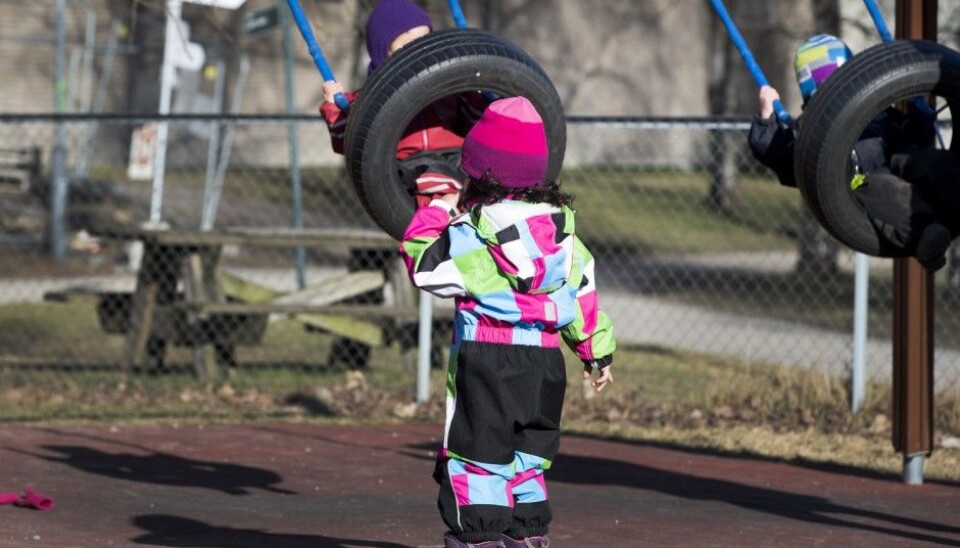This article was produced and financed by University of Stavanger

Traditional gender roles are still prevalent in early kindergartens
Staff in kindergartens expect boys to be physical and active when playing, while the girls must be quieter and calmer, says a study.
Traditional gender roles are still prevalent inchildhood education and care institutions (ECEC). This is the conclusion of a study based on the work experience observations of kindergarten pupils on the ECEC teacher training course at the University of Stavanger.
In the study, the students observed the expectations concerning the gender roles that girls and boys can encounter in ECEC. The students observed staff and children in their ordinary everyday routines. They looked at whether girls and boys are given equal opportunities in play activities and group sessions, without any restrictions stemming from traditional expectations concerning gender roles.
The results indicate that children are often limited by the traditional perceptions of ECEC staff concerning gender roles, and that the children themselves can break with traditional gender role patterns.
Different responses
Both Norwegian and international research shows that ECEC staff either consciously or subconsciously maintain traditional gender patterns when they interact with children.
"We did not expect the students to find the staff contributing to this to such an extent," says Aud Toril Meland, who together with Elsa Kaltvedt recently published the findings in Early Child Development and Care.
The study shows that the staff frequently commented on the children's appearance, responded to boys and girls in different ways and encouraged traditional stereotypical play even though the children themselves chose something else to do.
Sweet girls, tough boys
As regards the appearance of the children, the girls were told they were petite and lovely, while the boys were big and strong. This was sometimes also reflected in the references made by the ECEC staff to the children's clothing. The girls' clothing was referred to as "sweet" and "nice", while the boys' clothing was "tough" and "cool”.
The staff also discussed what they considered to be "girls' clothing" and "boys' clothing". One example of this was when a girl at the ECEC who usually wore typical "boys' clothing" suddenly turned up in a pink dress. She got comments from the staff about how sweet and pretty she looked in the dress. Other similar comments made to the girls included: "Oh, you look so sweet and beautiful today, a little princess!". "The boys did not receive such comments," says Meland.
Different expectations
The ECEC staff also had different expectations concerning the girls compared with the boys. The staff encouraged the girls to take part in typical care tasks.
When the girls laid the table, tidied up the room or helped younger children to take off or put on clothing, they were praised and told they were "kind and good little helpers".
Kaltvedt adds that this was sometimes also reflected in the attention given by the staff to the girls and boys. The boys were given more verbal and non-verbal responses, while the girls had to wait their turn and be patient.
Told to stop
In one example where several children were sitting together around a table and doing a puzzle, one of the girls tried to attract the attention of the staff without success. Immediately afterwards, one of the boys tried to attract the attention of the same member of staff and got an immediate response. The students observed many other similar situations.
Another surprising finding was that the students did not see many cross-boundary gender role patterns, i.e. where boys wanted to play with dolls and girls with cars, for example.
In the cases where the girls and boys played in an "untraditional manner", they were often treated by the staff based on a traditional gender role pattern.
Girls who ran around shouting loudly were asked to calm down; otherwise, they would be stopped from playing and encouraged by the staff to take part in calmer play activities, such as drawing or beading.
Not gender neutral
Meland believes that the staff's communication and manner with girls and boys was surprising.
"Our results indicate that girls have to fight harder in order to be seen; girls sit more quietly and wait, while the boys get confirmation and acknowledgement. The ECEC is therefore not gender-neutral," says Meland.
According to Meland and Kaltvedt, the Directorate for Education and Training no longer places any emphasis on the ECEC staff reflecting on their own attitudes and society's expectations concerning gender.
"However, ECEC staff should continue to analyse their own practice and work in order to counter traditional gender roles. The ECEC teacher training course must ensure that a knowledge of gender role patterns and equality is put on the agenda. Raising awareness and competence concerning repetitive gender role practice and how this can be broken must also be reinforced in both training and practice," they stress.
































